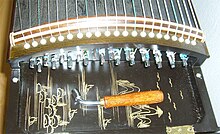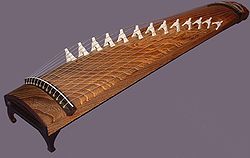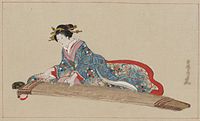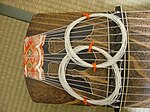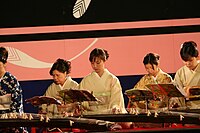Anne Prescott
June 2004
available in PDF format ( 142.97 KB  )
)
Contents
Physical description of the koto
History of the koto
Traditional Forms
Modern koto playing
How to Listen to Koto Music
Resources
The koto is one of the most popular traditional instruments in Japan and one of the best known outside of that country. Although many people think of it as an ancient instrument whose music has not changed for generations, in fact it is a vibrant, living tradition. The koto repertoire has a wealth of compositions from 17th-century classics to innovative contemporary works. This Digest introduces the instrument, its history and music.
Physical description of the koto

The standard koto is a zither (an instrument with strings stretched the length of the sound box) with 13 strings. It is about 6 feet long, 10 inches wide and 2 inches thick. When the player sits on the floor in the traditional manner the playing end is slightly elevated by a short stand (about 4-6 inches high) or by attaching two short feet. Today performers often sit on chairs, and then the koto rests on a stand called a rissodai.
<!–[endif]–>
The koto is constructed of two pieces: a hollowed-out top piece, which often has an intricate pattern carved on the underside for a better tone quality, and a flat bottom piece. There is a sound hole on the underside of the playing end and another hole for the strings to pass through on the opposite end. The koto is made from paulownia (kiri in Japanese) wood, which is very common in Asia but not indigenous to the United States. This wood is naturally very light brown in color, but to bring out the beauty of the wood grain, the kotokoto maker scorches the surface with a hot iron. The wood grain pattern (tightness and uniformity of the rings, direction of the wood grain pattern) helps the buyer of a new know if it will have a good sound or not. The carving on the underside of the top piece and how the two pieces are attached to each other also help to determine if it is a good instrument.
The strings of the koto are all the same thickness, although individual players may use slightly different thicknesses. Originally, koto strings were made of silk, but silk breaks easily, and most performers today use synthetic strings. A few professional koto players still use silk strings, particularly when they perform the traditional (pre-20th century) repertoire. Silk strings have a slightly softer, subtler sound than synthetic strings, and this sound is preferred for the older repertoire.
Under each string there is a moveable bridge which is used to tune the instrument. These bridges were originally ivory or wood tipped with ivory, but today nearly all players use plastic bridges. (Professional performers still use ivory bridges in performances.) The bridges are moved to tune the koto to one of a number of named pentatonic tunings.
Koto strings are strung very tightly, and when the bridges are removed to store or transport the koto, the strings lay flat along the surface of the instrument. Strings most often break near the playing end, so the extra length of string, which is coiled at the opposite end, is pulled down and the string is retied. Although advanced koto players can do this, they prefer to leave it to a professional koto shop technician, who routinely changes and tightens koto strings and is used to stretching them to the right tension quickly and easily.
Koto strings are plucked with plectra (picks) on the thumb and first two fingers of the right hand. The plectra are made of ivory or plastic and are attached to the fingers with leather or paper bands. There are two types of picks: Ikuta-ryû (school) picks, which are square, and Yamada-ryû picks, which are rounded (fingernail shaped).
History of the koto
Chinese musicians brought the koto to Japan from China in the Nara Period (710-794) as one instrument of the gagaku (court music) ensemble. By the mid-17th century the kotogagaku ensemble as a solo instrument to accompany songs. Until the 20th century, nearly all music for the koto was vocal music sung and accompanied by a single performer. The lyrics are from a variety of sources, including classic literature and poetry, and many famous tales are recounted in koto music. was more commonly used outside of the
The koto music performed today can be traced back to the mid-17th century and to Yatsuhashi Kengyô (?-1685), the father of modern koto music. Kengyô is an honorific title given to blind male koto masters, who were the professional teachers and performers in the Edo period (1600-1867). The majority of the students, however, were young middle- or upper-class women, because learning to play the koto was considered to be good training for becoming a proper wife.
The oldest koto piece known today is Rokudan no Shirabe (1) (usually known simply as Rokudan), but it is not typical of koto pieces prior to the 20th century because it is for solo koto with no vocal part. Rokudan, like many other koto works, can be played in various forms: solo koto (the melody written by Yatsuhashi Kengyô), koto duet, koto and shamisen2) duet, koto and shakuhachi(3) duet, or rarely, trio for koto, shakuhachi, or shamisen. One of the interesting things about this is that each part was usually written by a different composer, often at a different time. Even today, composers are writing new melodies for koto and other instruments to be played with Yatsuhashi Kengyô’s original solo version of Rokudan (4). (
A koto master named Ikuta Kengyô (1656-1715) started his own school (style) of kotoryû. Yamada Kengyô (1757-1817) developed a flashier style of koto playing, and this is known as the Yamada-ryû. Each school developed its own repertoire, and even today Ikuta school and Yamada school players rarely learn repertoire from the other school. As mentioned above, the two schools use picks of different shapes, which influences how some musical patterns are played. playing called the Ikuta-
Traditional Forms
There are three forms used in traditional koto compositions. The danmono form consists of a number of sections (dan) and each dan usually has 104 beats. Because each dan has the same number of beats, different dan can be played simultaneously in a form known as dan-awase. The kumiuta form is a collection of songs. Tegotomono are vocal works consisting of a vocal section followed by an instrumental interlude (tegoto) and concluding with another vocal section. The tegoto itself may be in the danmono form. In both the kumiuta and tegotomono forms, the lyrics for the vocal sections may be by different authors or from different literary works, but they are always on related themes. Prior to the 20th century very few koto works are in other forms, and even today composers sometimes utilize these traditional forms.
Modern koto playing
Japan was isolated from much of the outside world from the beginning of the Edo period (1603) until the Meiji Restoration of 1868. During this time, most Japanese people did not have the opportunity to hear new music from China or other countries. In addition, the musical culture encouraged imitation rather than innovation, so their music did not change much. Therefore, most koto music from this time sounds alike, with only subtle differences.
The end of the 19th century was a time of great modernization (Westernization) in Japan, and one of the changes was the introduction of Western music into the school curriculum. This had a great impact on koto music. By the 1920s people began to prefer the music they learned at school and fewer people listened to and learned traditional music.
With the decline in the number of people interested in traditional instruments in the 20th century, composers for those instruments tried to change the music to make it more attractive to the average person. The most influential of those composers was Michio Miyagi(5) (1894-1956). Miyagi composed more than 500 pieces in his lifetime, and his works incorporate new playing techniques, musical forms, and new instruments. Many of his new ideas came from Western music, and this made his compositions more accessible to ordinary Japanese. One of Miyagi’s most visible changes to koto music was his invention of the 17-string bass koto called the jûshichigen. He also composed many works for children to attract them to playing the koto. Miyagi’s Haru no Umi (Spring Sea), for kotoshakuhachi (1929) has become synonymous with the New Year’s holiday in Japan, and during that time it is commonly heard on television, radio and as background music. It is heard around the world in its original version as well as in transcriptions for violin, piano, orchestra, Chinese erhu (a 2-string bowed fiddle), Korean kayagum (a 12-string zither), and other instruments. and
Since the end of World War II there have been many radical changes to koto music. Composers from within the traditional Japanese music world (such as Shin’ichi Yuize, Tadao Sawai, Hozan Yamamoto, Shuretsu Miyashita, Shin Miyashita, Seiho Kineya and Kin’ichi Nakanoshima, Minoru Miki and Yutaka Makino) have created a great body of contemporary literature for the koto.
Tadao Sawai (1937-1997) was one of the most prolific, innovative, influential and best-known composers in the late 20th century. He composed works for both koto and shamisen in traditional forms as well as avant-garde works using new playing techniques and manipulating the koto in new ways. He also wrote many works for beginning and intermediate players, and his compositions are popular among young koto players.
Nihon Ongaku Shudan (Pro Musica Nipponia) was founded in 1964 by a group of performers on and composers for traditional instruments. This large-group ensemble broke with tradition by performing works for non-traditional combinations of instruments, including large ensemble works using many different instruments. In 1969 Pro Musica Nipponia members, composer Minoru Miki and koto master Keiko Nosaka, invented the nijûgen, a 20-string koto which has the same range as the 13-string koto. Pro Musica Nipponia often tours outside of Japan.
How to Listen to Koto Music
Listeners of Western music listen for vertical alignments, such as chords, or for interactions between musical lines. Late 20th-century koto compositions usually require Western listening strategies, but listeners of traditional koto music must ignore vertical alignments and listen to each line individually. In Western music, if two or more notes are played together, we hear the harmony produced, and we focus our attention on that harmonic movement. However, in traditional Japanese music when two or more notes are sounded at the same time, they are not meant to be heard as belonging together. Trained Japanese listeners perceive each musical line as a linear flow which is harmonically unrelated to the other musical lines occurring at the same time. Developing new listening strategies is important to appreciating koto music.
Notes
1. Rokudan no Shirabe is found on Splendour of the Koto.
2. The shamisen is a three-string lute.
3. The shakuhachi is an end-blown flute with five finger holes.
4. The recording of Rokudan on Splendour of the Koto is for koto and shamisen.
5. Japanese names are given in Western order (Michio Miyagi) rather than Japanese order (Miyagi Michio).
Resources
Books
De Ferranti, Hugh, Japanese Musical Instruments, New York Oxford University Press, 2000.
Malm, William, Traditional Japanese Music and Musical Instruments,
New York: Kodansha International, 2000.
Recordings
Tegoto: Japanese Koto Music; Tomoko Sunazaki, Fortuna
Tadao Sawai Plays Michio Miyagi, Playa Sound
Splendor of the Koto, Various Artists, Playa Sound
Web Sites
Information on the koto: http://koto.home.att.net
Instructions for kids to make their own koto at
http://www.kotoworld.com/kids.htm
Play the koto on the Internet at
http://www.genkienglish.net/genkijapan/koto.htm
or at
http://web-japan.org/kidsweb/virtual/koto/virtual-koto.html
(a « kid-friendly » site)
Mackay-Smith, Alexander, IV. « The Lost-and-Found Koto of
Yatsuhashi » http://www.asiasound.com/pages/learn/articles/lost.htm
Michio Miyagi: http://www.miyagikai.gr.jp (Japanese only)
Anne Prescott is an outreach coordinator at the East Asian Studies Center at Indiana University. Before coming to IU, she taught koto, East Asian music and Japanese culture at Augustana College in Illinois. She received her Ph.D. in ethnomusicology from Kent State University.



